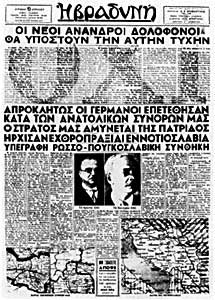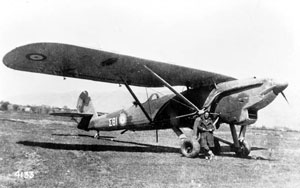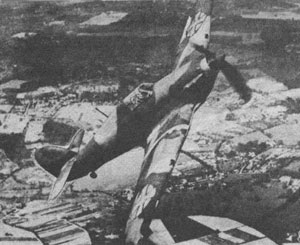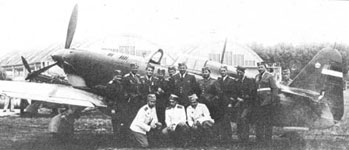| Left Up in the Air
The Air Services of the Low Countries in WWII
By David Meyler
November 2012
This article continues the examination of
the smaller air forces in Third
Reich and Great
Pacific War represented by those
single TAC factors. The first
article took a look at the Dutch and Belgian
air forces. This time we move to the Balkan
theatre with an examination of the air services
of the kingdoms of Greece and Yugoslavia.
Greece
The Royal Hellenic Air Force is perhaps
unique in being the only minor power to have
fought an long-term air battle largely on
its own during the Second World War, two full
game turns in the context of Third Reich.
This was not because the Greek air force was
large or unduly efficient but due to a set
of unique circumstances. The Greeks would
have been content to sit out the war, but
for Mussolini’s expansionist dreams.
Under the leadership of the governor of Albania,
Visconti Prasca, the Italians launched a very
ill-considered invasion of Epirus in northwestern
Greece in late October 1940. Prasca had failed
to allow for the limited port capacity in
Albania to bring in reserves of men and supplies.
Since he expected to defeat the Greeks within
a week, long-term logistical planning was
not done. The field army's immediate food
and ammunition supplies, good for only about
four days’ worth of campaigning, was
considered sufficient.

Greece’s answer to Mussolini:
Ochi! (Hell no!)”
On October 28, 1940, the Italian Tsamouria
and XXVI Corps (later expanded and reformed
into the 9th and 11th Armies) crossed into
Epirus from Albania. Over the first few days,
caught by surprise, the Greek 8th Division
appeared to be collapsing. But with the onset
of the wet autumnal weather, hurried reinforcements
and effective air support, the Italian advance
was stopped. It was not a war Hitler wanted.
The Greeks had no love lost for the Italians,
and while the Greek monarchy was pro-British,
the de facto head-of-state, General Ioannis
Metaxas, was a well-known fascist sympathizer.
While willing to accept limited British aid,
Metaxas was almost desperate to avoid open
confrontation with Germany, but even he could
not let the Italians walk into Greece without
a fight.
Prasca had made no logisitical arrangements,
had made no account for the heavy rain storms
typical for the season, and the air force
and navy commanders had not been informed
of the invasion plans until almost the proverbial
last minute. Within the first two weeks, the
Italian ground forces were stalled, already
desperate for supplies and facing a foe which
now outnumbered them. Valley roads turned
into a thick morass of yellow mud in the fall
rains, while units attempting to advance over
the mountains faced ice, sleet and snow.
The Regia Aeronautica, the Italian air force,
in Albania initially comprised four squadrons
of Savoia SM.81 medium bombers and two squadrons
of Savoia SM.79 medium bombers, a squadron
each of Fiat CR.32, Fiat CR.42 and Fiat G.50bis
fighters and three squadrons of Ro.37 reconnaissance
aircraft. Between November 1 and 5, two squadrons
of SM.79 bombers and six fighter squadrons
arrived (three each of G.50bis and CR.42),
bringing the total number of combat aircraft
based in Albania to 47 G.50s, 46 CR.42s, 14
CR.32s, 31 SM.79s, 24 SM.81s and 25 Ro.37s.
This force alone outnumbered the entire Greek
air force, but the 4th Air Flotilla based
at Brindisi, Italy, was also committed against
Greece with 16 bomber squadrons (60 Cant Z.1007b's
and 23 Z.506s, 18 SM.81s, 18 Fiat BR.20s),
two dive-bomber squadrons (20 Junkers Ju87s)
and four fighter squadrons (33 G.50s, 12 Macchi
C.200s and nine CR.32s).

A Greek Do.22 before a mission, 1940.
Most of the Greek air force would be concentrated
in the Epirus region, but this just totalled
three squadrons of PZL P24 fighters (24 operational
aircraft in total) and three light bomber
squadrons (eight Potez Po63s, 11 Blenheim
IVs and ten Fairey Battles). The Italians
would begin with a numerical advantage of
6 to 1 in aircraft. But even when good weather
allowed, the Italian air force could never
translate this advantage into air superiority.
On October 28, the Italians managed to send
some bombing raids against the Dolian-Kalibaki
road, but the next day the inclement weather
precluded all aerial operations. On October
30, Greek Hs126’s made a number of sorties
over Kastoria, but lost two aircraft against
Italian CR.42’s. The following day,
bad weather again restricted operations.
Greek reconnaissance aircraft were active
over the front, but the weather had cleared
sufficiently on November 1 to allow for increased
Italian fighter activity. A flight of two
slow BrXIX biplanes was bounced and both aircraft
shot down by three Fiat CR.32’s. Italian
ground forces received little direct support
as their air force concentrated on strategic
targets. The Aegean port of Salonika was repeatedly
hit. The Greeks had little strategic power,
but a trio of Greek Blenheim bombers struck
back at the main Italian air base in Albania
at Koritza.
In spite of early morning fog on November
2, the Greek air force sent out the lumbering
BrXIX’s once again, on patrols along
the front covering Samarina, Romios, Kerassovon
and Fourka. At about 0700, Italian troop and
pack mule columns were spotted moving on Distraton.
Bombing raids were sent out as quickly as
they could be organized. The Regia Aeronautica
intensified its attacks with raids against
Ioannina, Larisa, Corfu, Patras and Salonika.
With fresh battalions arriving, the Greeks
increased the pressure on the Italians, but
November 4 was largely spent consolidating
their positions won the day before. Italian
fighters strafed Greek troop concentrations
while Greek BrXIX’s continued their
attacks in the Distraton area. Three were
caught by Italian Fiats and only one escaped.

Greek Gladiator.
As winter weather closed in and losses,
and wear and tear eroded Greek strength (there
being virtually no replacement aircraft and
few spares and parts), operations of the Royal
Hellenic Air Forces steadily diminished. Andreas
Antoniou of the 22nd Mira was the highest
scoring Greek pilot with five victories.
General Metaxas died January 29, 1941. The
king chose Alexandros Koryzis as his successor.
Metaxas had steadfastly turned down British
offers of military assistance, although some
air support had been accepted and supplies
of weapons and ammunition were welcomed. He
feared that the arrival of British land forces
could only result in a German invasion of
Greece to aid their Italian allies, and an
open war with Germany was the last thing Metaxas
wished to have. With the dictator out of the
way, however, the king and Koryzis were free
to follow an openly pro-British policy.
Hitler, meanwhile, began to grow more alarmed
with each successive Italian failure. The
longer the war went on, the more likely British
intervention became. Germany's chief concern
was the threat to the Romanian oil fields,
and they were already in range of British
bombers based in Greece. The defeat of the
last Italian offensive in March, the arrival
of British combat forces in Greece, and Yugoslavia's
rejection of a German alliance later that
same month convinced Hitler of the need to
occupy both Yugoslavia and Greece. The blow
fell on April 6.
The British supplied a few replacement aircraft,
but only the following formations remained
operational: 21st Mira (Gloster Gladiators),
22nd and 23rd Mire (PZL P24s), 24th Mira (Bloch
MB151s) -- about two dozen fighters in total.
Only remnants of the bomber, support and naval
squadrons remained with almost no operational
aircraft. Like the army, the air force was
quickly overwhelmed by the German invasion.
Greek Order of Battle, October 1940
Elleniki Vassiliki Aeroporia (Royal Hellenic
Air Force)
Fighter Command:
- 21st Mira (squadron) (Kalambaka/Ioannina),
12 PZL P24 (serves as the icon on the Greek
TAC)
- 22nd Mira (Thessaloniki/Sedes), 12 PZL
P24
- 23rd Mira (Larisa), 12 PZL P24
- (Out of the 36 P24’s, just 24 were
operational at the time of the Italian invasion.)
- 24th Mira (Elevsis), nine Bloch MB151
(just six operational — provided for
the air defence of Athens)
Bomber Squadrons:
- 31th Mira (Niamata), eight Potez Po63
- 32nd Mira (Larisa), 11 Blenheim IV
- 33rd Mira (Kouklaina), ten Fairey Battle
- Ground Support/Reconnaissance Squadrons:
- 1st and 2nd Mire, nine operational BrXIX
between them
- 3rd Mira, 15 Henschel Hs126
- 4th Mira, 17 Potez Po25A
Naval Aviation:
- 11th Mira, nine Fairey IIIF; 12th Mira,
12 Dornier Do22G; and 13th Mira, nine Anson
flying boats
Yugoslavia
While the Yugoslav army proved to be a paper
tiger, the air force of the kingdom was an
exception. It was relatively large for a smaller
power, with about 800 combat aircraft. It
was also relatively well equipped with Hawker
Hurricanes and Messerschmitt Bf109’s
as its principal fighters. And compared to
the army, at least, it was ethnically united.
Still, shortly before the German invasion,
a Croatian officer defected to Germany with
details of the air force's deployment. As
well, a large number of aircraft were not
operational when war broke out (there were
487 operational aircraft, of which half were
modern).

A Royal Yugoslav Hurricane.
Not fully mobilized, suffering from poor
communications and suffering heavy losses
on the ground at the hands of the Luftwaffe,
the air force never had a chance to offer
an organized resistance. Some squadrons did
not realize the war was on for some hours.
The native-designed and -manufactured Ikarus
Ik3 fighter proved effective over Belgrade
(a low-wing monoplane fighter similar in profile
to the Hawker Hurricane, the Ik3 was an excellent,
modern design whose only real weakness was
lack of numbers: 527 km/hour, one 20mm cannon
and twin 7.9mm machine guns in the front fuselage,
although the name “Icarus” was
not perhaps a good omen.) In what is considered
the Yugoslav’s air force’s finest
hour, 32nd Grupa’s 6 IK3 and 12 Bf109
accounted for 12 German Messerschmitts. However,
these efforts could not save Belgrade from
suffering severe damage from the Luftwaffe’s
repeated bombardments, killing thousands of
civilians. Milislav Semiz, flying an Ik3,
claimed four victories during the brief campaign.
The most successful air action was an attack
by the SM.79 bombers of 66th and 67th Grupa
against German columns pursuing Yugoslav army
forces into Kosovo. Fighter units fought in
vain to cover the various retreating units
of the army, and by April 12, all aerial operations
had ceased, and many remaining aircraft were
set on fire. However, much of the surviving
equipment was handed over to the air force
of the puppet Croatian state established after
the surrender of Yugoslavia.

Yugoslav pilots pose in front of an IK-3.
Yugoslavian Order of Battle, April 1941
Jugoslovensko Kraljevsko Ratno Vazduhoplovstvo
(Royal Yugoslovian Air Force)
2nd Lovacki Puk (fighter regiment)/1st
Brigada:
- 31st Grupa (squadron) (Kragujevac) 11
Messerschmidt Bf109E (two flights or eskadrila)
- 51st Grupa (Knic) 18 Hawker Hurricane
I (two flights)
- 6th Lovacki Puk/1st Brigada:
- 52nd Grupa (Zemun) ten Messerschmidt
Bf109E, one Messerschmidt Bf110 (captured)
(three flights)
- 32nd Grupa (Krusevac) six Ikarus Ik3
(used as the icon on the Yugoslav TAC),
34 Messerschmidt Bf109E (only about 12 operational)
(three flights)
4th Lovacki Puk/2nd Brigada:
- 33rd Grupa (Bos. Aleksandrava) 14 Hawker
Hurricane I (three flights)
- 34th Grupa (Bos. Aleksandrava) six Hawker
Hurricane I, eight Ikarus Ik2 (three flights)
- 8th Bombarderski Puk (bomber regiment)/2nd
Brigada:
- 68th Grupa Squadron (Ravine) 11 Bristol
Blenheim I (two flights)
- 69th Grupa (Ravine) 12 Bristol Blenheim
I (three flights)
3rd Bombarderski Puk/3rd Brigada:
- 63rd Squadron (Petrovac) 36 Dornier Do17
(three flights)
- 64th Squadron (Milosevo) 36 Dornier Do17
(three flights)
5th Lovacki Puk/3rd Brigada:
- 35th Squadron (Leskovac) 16 Hawker Fury
(two flights)
- 36th Squadron (Kumanovo) 14 Hawker Fury
(two flights)
1st Bombarderski Puk/4th Brigada:
- 61st Squadron (Bijeljina) 11 Bristol
Blenheim I (two flights)
- 62nd Squadron (Davidovic) 12 Bristol
Blenheim I (two flights)
7th Bombarderski Puk /4th Brigada:
- 66th Squadron (Preljina) 15 SM.79 (two
flights)
- 67th Squadron (Gorobilje) 15 SM.79 (two
flights)
Independent Squadrons:
- 81st Bombarderski Grupa (Stanceval) 15
SM.79 (two flights)
- 11th Izvidjacka Grupa (recon squadron
(Radinci) nine Bristol Blenheim I, two Hawker
Hind (two flights)
- Independent Eskadrila (Stanceval) three
Hawker Hurricane I, three Messerschmidt
Bf109E, three Avia BH33E
Army Aviation Units:
- First Army, 1st Izvikdjacka Grupa (15
aircraft)
- Second Army, 3rd Izvikdjacka Grupa (19
aircraft)
- Third Army, 5th Izvikdjacka Grupa (14
aircraft)
- Fourth Army, 4th Izvikdjacka Grupa (18
aircraft)
- Fifth Army, 2nd Izvikdjacka Grupa (16
aircraft)
- Sixth Army, 7th Izvikdjacka Grupa (18
aircraft)
- Seventh Army, 6th Izvikdjacka Grupa (16
aircraft)
- Coastal Army Area, Independent Eskadrila
(four aircraft)
- (In total, 120 Breguet BrXIX and Potez
Po25)
Naval Aviation:
The small naval air service was organized
into four groups with a total of 11 Dornier
Do "Wal", 12 Dornier Do22 and 12
Rogozorski SimXIV floatplanes.
Select Bibliography
Buchner, Alex. Der Deutsche Griechenland-Feldzug,
Kurt Vowinckel Verlag, Heidelberg, 1957.
Montanari, Mario. La Campagna di Grecia,
Stato Maggiore dell'Esercito, Rome, 1980.
Pantazes, Konstantinos. Ta Dyo Ochi,
Dodone, Athens, 1972. (A detailed account
in Greek of both the Italian and German invasions
of Greece.)
Shores, Christopher. Air War for Yugoslavia,
Greece and Crete, 1940-41, Grub Street, London,
1987. (Provides detailed accounts of both
the Yugoslav and Greek air forces.)
Terzic, Velimir. Slom Kraljevine Jugoslavije
1941, Narodna Knijga, Belgrade, 1980.
(The official Yugoslav account of what is
called the April War, the German invasion
of the Yugoslav kingdom in 1941, considerable
detail on both operations and organization
of the Royal Yugoslav forces. Available in
both Croatian using the Roman alphabet or
Serbian in Cyrillic script.)
Order Third Reich while you still can! |


